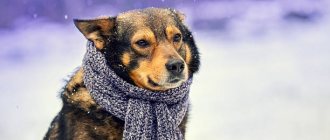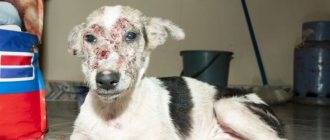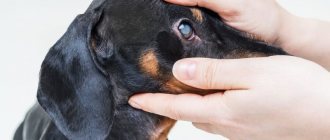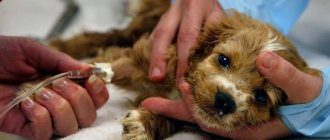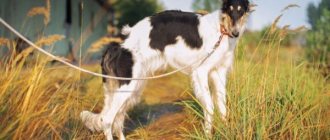Features of the disease
Ringworm can affect dogs of all ages. An infected animal spreads fungal spores.
Danger to humans
When spots on the skin or bald spots appear on animals, the question arises: is this disease transmitted to humans? People can become infected with ringworm through contact with a sick animal.
Children are especially susceptible to infection. This is due to immature immunity. A sick child or adult can transmit the infection to healthy pets and other people.
Distribution source
The source of infection is the fur of sick animals . The fungus penetrates the threads of hair mycelium and remains there for up to 4 years. The infection enters the external environment with flakes of skin or fur.
In the city, stray animals can spread microsporia: cats, dogs, rats. In the village, the source of lichen infection is rodents.
Infection occurs through contact with domestic or stray animals, or through care items.
Does it go away on its own?
The disease cannot be ignored. It will not disappear on its own. Treatment is carried out immediately after detection of foci of infection.
Therapy is aimed at localizing the affected areas in order to reduce the release of fungal spores into the environment.
How is the diagnosis carried out?
Since microsporia is contagious, it should be treated as soon as you notice the first signs of infection. To make sure what exactly needs to be treated and what medications to prescribe, the veterinarian performs a diagnosis.
The first test that will confirm the fungal nature of the disease is diagnostics with a Wood's lamp. In its ultraviolet light, the fungi will fluoresce if the infection has occurred with Microsporum canis. The shade of the glow is apple green. M. gypseum or M. persicolor do not fluoresce.
Therefore, the next step will be to study the culture of the fungus. Hair and/or scrapings removed from the affected areas are placed in Sabouraud's medium. This is a special gel in which the mushroom must germinate. The germination process can take up to 4 weeks. As a result, the specific type of fungus that has infected your pet will be confirmed.
Ways of infection of a dog
A pet can become infected with microsporia in several ways, not necessarily through contact with sick stray animals.
Environment
Your pet can become infected with ringworm while walking.
Sources of infection are soil or vegetation. In the soil, fungal microspores persist for up to 2 months. Some persistent fungal spores remain active in moist soil for up to 10 years.
Contact with other animals
A pet most often becomes infected with ringworm from stray dogs or cats.
Microspores remain in wool for up to several years. During this period, animals are a source of infection.
Re-infection
Microsporia produces a huge number of spores that are active for an extended period. If an animal has microsporia, all things with which the pet has been in contact are disinfected.
The bedding, toys and feeder are washed with a 2% solution of formaldehyde and 1% sodium hydroxide. After the animal has fully recovered, veterinarian control is carried out for another month, otherwise re-infection is likely.
Vaccines against lichen
Vakderm
The vaccine is administered intramuscularly into the hind limbs (first in one, then in the other) twice with an interval of two weeks. The dose is determined by the weight of the dog - less than 5 kg, 0.5 ml is administered, if the weight is more, then 1 ml. As a side reaction, a small painful lump may appear at the injection site, which will go away on its own in 3-5 days. After the second injection, the therapeutic effect occurs within a month and new hair begins to grow on the affected areas. Immunity after vaccination lasts up to a year. 1 dose of the vaccine costs about 100 rubles, it is stored in the refrigerator.
Microderm
Vaccination is carried out according to the same scheme. The dosage is slightly different: puppies up to six months are given 0.5 ml of the drug, all dogs older than 6 months are given 1-2 ml depending on weight. A package containing 4 ampoules costs 360 rubles.
Diagnostics
The first symptoms of a fungal infection cannot always be seen with the naked eye. Veterinarians use special devices and diagnostic methods.
Wood's lamp
Ultraviolet radiation, illuminating surfaces, causes foci of fungal infection to glow green. The inspection is carried out in a dark room.
A pet with spots or areas of baldness that causes concern to the owner is brought in for an appointment. Examination under a Wood's lamp will not take more than 5 minutes. This is a fast and inexpensive method for diagnosing mycoses.
False result
A negative examination result cannot exclude microsporia if there are symptoms of fungal infection.
The fungus may not glow under a lamp when using certain medications, or if the lesions have been treated with iodine.
Examination under a microscope
Examination of pathological material under a microscope helps to more accurately determine the causative agent of infection.
A scraping is taken from the affected area of skin with a scalpel. The collected material is decolorized with potassium hydroxide or phenol, then examined under a microscope. Diagnostics is accurate and informative.
Bacterial culture
The causative agent of a fungal infection can be identified by growing its spores in a nutrient medium. For diagnosis, a scraping is taken from the affected areas of the skin or a section of hair. The lesions are identified using a Wood's lamp.
Colonies of bacteria grown in a nutrient medium under a lamp cause a red glow.
Consequences of infection
Convex pink spots appear on the skin of an infected dog. This occurs due to the activity of fungal microspores, which enter the surface layers of the skin and begin to actively multiply. Superficial inflammation occurs.
If the fungus penetrates into the deeper layers of the skin, acute dermatitis will develop and an abscess may begin.
Forms and symptoms
Microsporia in dogs can occur in several forms:
- superficial;
- deep;
- erased;
- hidden.
Most often, superficial and deep microsporia are diagnosed. After infection there is an incubation period that can last up to 47 days. After this, the animal begins to show external symptoms of microsporia.
At first it is minor redness and peeling of the skin. The lesions initially resemble cigarette burns. These are pronounced red spots with a gray rim. The fur gradually begins to fall off. It becomes dry and brittle. The area of hairless areas is constantly increasing. The spots can reach several centimeters in diameter. In these areas, skin scales begin to peel off and crusts form.
Without appropriate treatment, the affected areas may become susceptible to secondary bacterial infection, which subsequently leads to sepsis. If the lesions are located between the dog's toes, they may not be noticed immediately. And for a long time the animal becomes a carrier of the fungus, which is also dangerous for humans.
Clinical picture
Like any other disease, trichophytosis has its own characteristics. Symptoms of the lesion may not appear for a long time, and when they occur, treatment is carried out immediately .
Incubation period
The fungus, when it gets on the skin or fur of an animal, can multiply within 3 days or 1.5 months without symptoms. How long a dog will be a carrier of a fungal infection without getting sick from it depends on the strength of the pet’s immunity.
Damage to the scalp
The fungus, when it gets on the animal's fur, grows in the hair follicle. The hair is destroyed, becomes brittle, short, and the coat thins.
Spread of spores
As the fungus multiplies, the animal’s skin also suffers. Some areas become bald, the surface of the skin becomes inflamed, red, and peels. Allergic reactions often appear - itching, rashes.
In advanced cases, small spots merge into huge foci of inflammation spread throughout the body. They itch unbearably, peel, and become moist.
What is microsporia and where does it come from?
The disease microsporia, caused by fungi, affects the skin, fur and claws of the animal. The spores that contribute to infection are found everywhere - in the grass, on the soil and are very tenacious. Not only cats that often walk are at risk of contracting lichen - pets can be infected by humans by introducing fungal spores, for example, on shoes.
Young pets, weakened animals or cats with a low level of immunity are most susceptible to developing pathology. With good immunity, infection may either not occur at all, or, if the cat does get sick, it will be possible to get rid of the pathology quite quickly.
One of the categories most susceptible to Microsporum infection is kittens.
What is the danger of microsporia for animals and humans?
At first, lichen appears only in small areas of the skin. If the pathology is not detected in time and treatment is not started, the extent of the damage will quickly increase. In severely advanced cases, a bacterial infection may develop, which will lead to deformation of the claws and negative changes in the internal organs. In kittens, a complicated form of the disease can be fatal.
A person can become infected after contact with an animal or through care items. This disease is especially dangerous for children and the elderly. Ringworm causes both physical and psychological discomfort in humans and requires long-term and complex treatment.
Forms of microsporia
Ringworm has 3 stages. Each of them has specific symptoms and course of the disease.
Superficial
The dog's coat becomes dry and dull.
The hair breaks off and thins. Small balding areas appear on the skin; over time, they become crusty and peel off. The disease can last several months or last for years.
Deep
Pink spots on the skin become larger and denser. The hair follicle fills with pus and fluid is released when pressed. The skin around the hairs becomes whitish or gray.
The symptoms are pronounced, treatment cannot be delayed.
Hidden
The animal constantly itches, hair falls out, and allergic reactions appear. An adult dog can suffer from a latent form of microsporia for several years. The danger of such deprivation is the spread of infection to sick animals.
Erased (atypical)
It appears in the warm season in adult animals; this form of fungal infection does not occur in puppies.
Warts or abrasions appear on the dog's body. Small swellings or small spots may form, this looks like a shallow skin injury. Often the owner does not associate these neoplasms with lichen.
Only a clinical analysis will reveal the causative agent of the infection.
Symptoms of the disease
Microsporia begins to develop immediately after the spores come into contact with the healthy skin of the animal. They grow into its deep layers, where the inflammatory process begins. Severe itching appears and the dog begins to scratch the affected areas of the skin. Gradually, the mycelium of the fungus grows even more, and under the influence of toxins and enzymes secreted by the fungus during its development, the keratin of the stratum corneum of the skin and hairs is destroyed.
As a result, the hairs break off at the very roots, and a spot devoid of hair appears on the dog’s skin. The skin in this area becomes red, thickens and begins to peel.
In dogs, ringworm can develop with varying intensity, so the following forms of this disease are distinguished:
- superficial;
- deep;
- erased;
- hidden.
The first three forms can occur in dogs of any age, including very small puppies, the last - in adult animals over 1 year old. They manifest themselves in different ways. At the initial stage of the disease, there may be no symptoms: the skin looks healthy, no hair loss is observed. But even with the superficial form of microsporia, dogs’ hair begins to fall out and bald spots appear on the body.
With a deep form, the skin of animals is more affected by the fungus, and therefore all the symptoms become more pronounced. The itching becomes more intense, dogs scratch the skin more strongly, as a result of which crusts appear on it. Round spots of lichen can be of different sizes, small ones often merge into large lesions. Fortunately, the deep form of the disease is quite rare.
Lichen spots in dogs are localized mainly on the croup near the tail, on the head near the ears, muzzle and paws, but can also occur on other parts of the body.
Treatment methods
Ringworm is treated at the first sign, as it is contagious to everyone - people and animals. A sick pet is a carrier and spreader of the infection.
Therapy, its duration
Treatment is aimed at localizing the lesion and destroying it as quickly as possible. The spread of the pathogen in the environment must be stopped as soon as possible.
Treatment of trichophytosis is a long, continuous, regular process. The course of antifungal therapy is at least 40 days, then another month of observation by a veterinarian.
Local processing
For better penetration of medicines into the skin, the hair on them is removed. If this is not possible, the hair is treated with special antifungal shampoos.
Local agents:
antifungal ointments: Clotrimazole, Miconazole, Ketoconazole - synthetic antifungal agents for external and local use;- salicylic ointment is indicated for weeping lichen;
- sprays and ointments with tar: Kubatol, Wilkinson ointment;
- Xeroform powder or powder;
- antiseptic Chlorhexidine.
Treatment is carried out as prescribed by the veterinarian, strictly following the instructions for the drugs.
Shampoos
Not all owners of pet dogs know whether it is possible to wash their dog if it has shingles. Veterinarians recommend the procedure, but it is recommended to use shampoo that contains antifungal substances.
Among the effective detergents are the following:
Keto plus;- Nizoral;
- Sebozol;
Treatment with shampoos is carried out for 10 days. Afterwards, the result is secured with a prophylactic against ringworm – Ecoderm. The drug is used for 2–3 months.
Griseofulvin
The drug is prescribed for microsporia in dogs as an antifungal antibiotic. It is given with food. The absorption of the product is weak, most of it accumulates in the upper layers of the skin.
Griseofulvin is an effective drug for ringworm, but in dogs it causes a number of side effects: vomiting, diarrhea, and increased levels of liver enzymes.
An antifungal drug for humans, Terbinafine, is also used in veterinary practice. It is given to the animal 20 mg per 1 kg of weight once a day. The course of treatment is 4–6 weeks.
Vaccination
During treatment for microsporia, Microderm vaccination is used. The drug is intended not only for the prevention of ringworm, but also for its treatment.
Vaccine injections are given twice with a 14-day break.
Features of prevention
An important point in preventing and eliminating infection is cleaning the premises. The environment is a source of reinfection of the dog. It is necessary to maintain cleanliness by collecting dust and carrying out wet cleaning. But mechanical cleaning is not effective without disinfection. Therefore, after removing garbage, it is necessary to treat the room with 10% sodium hypochlorite.
Vaccination cannot be considered an effective method of preventing microsporia. The experiments carried out show a negative result (infection after vaccination) in many domestic animals. This is due to the fact that the vaccine provides short-term immunity, so it is advisable to use it for healthy and sick animals if pathology is detected in one of them.
The owner should check their pet regularly. Any changes in skin, coat or behavior (itching, head shaking) should not be ignored. If you notice a receding hairline on your dog, you should contact your veterinarian. The disease rarely goes away on its own and takes several years, and all this time the dog will pose a danger to other animals and people.
To reduce the risk of microsporia infection in a dog, it is necessary to limit contact with stray animals. Walking should be done only in special areas and under personal supervision. In a private house, it is necessary to equip an enclosure into which foreign animals cannot get into.
It is important to combat mice and rats, which are a natural reservoir of microsporia. Owners should also limit communication with other animals, as the owner can act as a carrier of infection.
Microsporia develops more often in puppies and dogs with weak immune systems. It is important to protect your pet from external irritants in the first year of life, when he has increased sensitivity. All vaccinations and treatments against parasites must be carried out in a timely manner in accordance with the veterinary action plan.
A healthy dog kept in good conditions and receiving a balanced diet rarely suffers from microsporia.
Sources:
https://yarus-spb.ru/sobaki/bolezni/mikrosporiya-sobak.html
Prevention of microsporia
Treatment of the pathology is long-term, so that infection does not occur; prevention of the disease is important.
Luminescent diagnostics
Every time your dog is examined by a veterinarian, it is recommended to undergo a Wood's lamp examination.
This rapid diagnostic method quickly identifies the lesion.
Vaccinations
Dogs are vaccinated annually against many diseases. There are also effective vaccines against microsporia: Biofel-M plus, Biocan-M, Microderm .
Explanatory work
Veterinarians and sanitary doctors should work with the population to warn about the dangers of ringworm. You should not feed stray animals at entrances, and children should not be allowed to pet them.
Home inspection
Pet owners should regularly inspect their pet's fur. The appearance of bald patches, rashes, and redness should alert you. During this period, the pet can be contagious to all family members.
Immediate contact with a veterinary clinic is encouraged.
No dangerous contacts
Pet dogs can only be walked on a leash. Meetings with stray dogs should not be allowed: they are the main carriers of infection.
Strengthening the immune system
A pet's diet should be varied.
Walks at any time of the year are long. The animal should also take a course of vitamins in spring and autumn after consulting a doctor.
Diagnosis of microsporia in dogs
It is impossible to make an accurate diagnosis based on the type of lichen spot alone, because microsporia is similar to other skin diseases, including non-contagious ones. Therefore, to make an accurate diagnosis, it is necessary to bring the dog to the veterinarian for examination.
The fastest way to detect microsporia is to examine the surface of the animal's body under a Wood's or MiG lamp. To do this, the dog is irradiated with a lamp in a dark room for 5 minutes.
If she is suffering from ringworm, then the affected areas will glow with an emerald green glow. This method allows you to differentiate microsporia from scab.
Another diagnostic method by which microsporia is detected is the study of biomaterial taken from a sick dog under a microscope. To do this, they scrape off the skin flakes and crusts that are on the border with healthy skin. Examining a sample under a microscope can confirm or refute the presence of microsporia in a dog. Growing the pathogen on a nutrient medium also gives good results.
Prevention
Both pets and people are susceptible to microsporia. Often, when faced with this problem, all family members need medications.
Measures to prevent illness:
- No contact with sick people and animals.
- Avoid sharing items with people who have had this disease in the recent past.
- Maintaining hygiene rules.
- Vaccination. The most well-known drugs are: “Vakderm”, “Mikolam”, “Mikoderm”, “Polivak”, “Mikkanis”.
- Refusal to visit places where stray animals gather.
- Maintaining good health and high immunity in the dog.
Most owners prefer vaccination against this fungal disease. This solution eliminates the hassle associated with treating this disease.
Symptoms
- lumpy, clearly defined, raised, highly inflamed skin lesions with a diameter of 2-4 cm,
- patchy hair loss primarily appears on the head, near the ears, on the bottom of the paws or near the tail,
- peeling skin,
- the areas where the baldness occurred may appear slightly red , although the skin nearby (under the fur) will have its usual pale color,
- In some places there is severe itching .
Ringworm in dogs and cats
Ringworm in dogs and cats is divided into two types.
- In the first case, we are talking about trichophytosis, which is caused by Trichophyton.
- In the second - microsporia.
The body of pathogens is filamentous in nature. These fungi are characterized by the formation of many spores. This explains their widespread distribution in the environment. Their resistance to high temperatures and disinfectants is noted. In this regard, it is quite difficult to fight these fungi.
Rodents are the main carriers of fungal infections. Infection of dogs and cats is facilitated by unfavorable conditions of their feeding and keeping. This is especially true for homeless animals. This infection also spreads due to unfavorable weather conditions. It is worth noting that ringworm is very dangerous for children. This is due to the possibility of infection through contact with sick pets.
Clinical picture of the disease
The incubation period is 1-4 weeks. As a rule, the course of this pathology is chronic. Small bald round spots form on the skin of a sick animal. On their surface there are scales and grayish crusts. As a rule, the localization of the lesion is the neck, head and limbs. Lack of treatment can lead to the formation of one large spot. In this case, a large surface of the body is affected. Itching is not typical for ringworm.
An extensive form of trichophytosis is accompanied by suppuration of the hair follicles. This variant of pathology is more common in dogs. Cats usually have microsporia. The localization of microsporic spots is the face, body, tail, limbs and ears of cats. At the site of the spots, hair loss and breaking occurs. If left untreated, ringworm can last for several months. During this time, severe exhaustion of sick animals is noted.
Diagnostics
The diagnosis of ringworm in dogs and cats is based on characteristic clinical manifestations and laboratory results. As a rule, a microscopic examination of scrapings from the affected skin areas is performed. The use of luminescent analysis is indicated for early diagnosis of microsporia in cats. To carry it out, you need ultraviolet rays and a darkened room. If there is a pathology, the animal's hair glows with a greenish glow.
Treatment of the disease
Affected skin areas should be softened and washed off with warm water and soap. To lubricate unaffected areas of the skin, use iodine monochloride, salicylic alcohol or ointment, juglone. You can also rub trichothecin liniment into the skin. It is envisaged that the treatment of the animal will be repeated three times.
We recommend reading: Is it possible to eat eggs from chickens with coccidiosis?
Significant damage is considered an indication for abundant moisturizing of the skin with cotton swabs and bleach. After this, it is recommended to apply superphosphate powder to the skin and rub it in. Rubber gloves are required for this treatment of the animal. This procedure leads to the formation of dense whitish films. After a week, they peel off and the affected areas become overgrown with hair. To systemically combat fungal infections, griseofulvin is prescribed. When treating animals, it is necessary to disinfect the premises, care items and clothing of people.
An extensive form of trichophytosis is accompanied by suppuration of the hair follicles. This variant of pathology is more common in dogs. Cats usually have microsporia. The localization of microsporic spots is the face, body, tail, limbs and ears of cats. At the site of the spots, hair loss and breaking occurs. If left untreated, ringworm can last for several months. During this time, severe exhaustion of sick animals is noted.

